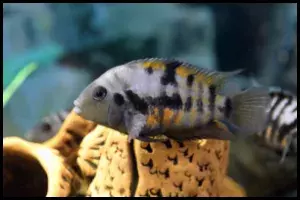
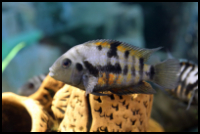
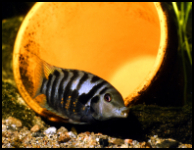
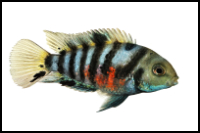
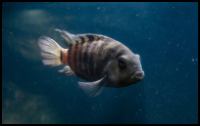
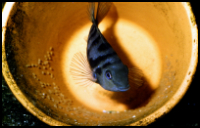
Quick Care Details (Table)
| Livestock Characteristics | Value |
|---|---|
| Care Level | Moderate |
| Temperament | Aggressive |
| Diet | Omnivore |
| Maximum Size | 6 Inches |
| Minimum Tank Size | 30 Gallons |
| Plant Safe | Yes |
| Temperature Range | 78-84 |
| PH Range | 6.6-7.8 |
| KH Range | 10-15 |
Species Specific Categories
Helpful Video
Care Details
Aquascape: When aquascaping for Convict Cichlids, consider providing hiding places and territorial boundaries using rocks, caves, and driftwood. They prefer a setup that replicates their natural habitat, which includes rocky crevices and caves. Keep in mind that they can be quite territorial, so providing hiding spots is essential.
Substrate: A fine gravel or sand substrate is ideal for Convict Cichlids. They often dig pits and construct nests in the substrate, so it should be smooth to avoid injuries.
Disease Prevention: Maintaining good water quality, a balanced diet, and quarantining new fish before introducing them to the main tank are crucial for disease prevention. Convict Cichlids are hardy but can be susceptible to common aquarium diseases if conditions are not optimal.
Filtration: A strong and efficient filtration system is essential to keep the water clean and well-oxygenated. Canister filters or powerful HOB (hang-on-back) filters are commonly used for Cichlid tanks.
Lighting: Convict Cichlids don't have specific lighting needs, but a standard aquarium light that supports live plants (if you have them in the tank) should suffice. Ensure a consistent day-night cycle to mimic their natural environment.
Water Flow: They prefer gentle to moderate water flow. Consider using a filter outlet or decor to disperse water flow and reduce strong currents in the tank.
Hardiness: Convict Cichlids are known for their hardiness and adaptability to a range of water conditions. However, stable water parameters are still essential for their well-being.
Acclimation: When introducing new Convict Cichlids to your tank, practice proper acclimation. Slowly adjust them to the water conditions by floating the bag in the tank and gradually adding tank water over time to reduce stress.
Expected Lifespan: With proper care, Convict Cichlids can live for an average of 8-10 years. This lifespan can vary depending on their care and tank conditions.
Special Requirements: While they are generally hardy, Convict Cichlids can be aggressive, especially during the breeding season. It's advisable to provide hiding places and territories to prevent excessive aggression. Additionally, if you plan to keep them in a community tank, choose tankmates carefully, as not all species are compatible with Convict Cichlids.
Temperament and Behavior
Behavior: Convict Cichlids are known for their interesting and sometimes aggressive behavior. They are territorial and can be quite assertive, especially when breeding. They often dig pits in the substrate and establish territories within the aquarium. They may also rearrange the tank decor to suit their preferences.
Breeding: Breeding is a common and fascinating aspect of Convict Cichlid behavior. They are prolific breeders and can be quite attentive parents. They often form pairs and lay their eggs on cleaned surfaces, which they guard vigorously. The fry are well cared for and may even be protected by both parents.
Aggression: Convict Cichlids can be highly aggressive, especially during the breeding season. They may attack other tankmates, including fish that are much larger than themselves, to defend their territory and young. Be cautious when choosing tankmates, as compatibility is essential to prevent excessive aggression.
Tankmates Compatibility: When selecting tankmates for Convict Cichlids, choose species that can tolerate their territorial and occasionally aggressive behavior. Some suitable tankmates include other robust cichlid species, larger fish that are not easily intimidated, and fish from Central and South America that share similar water parameter preferences. Avoid keeping them with small, passive fish or fin-nipping species.
Activity Level: Convict Cichlids are generally active fish. They spend a lot of time patrolling their territory, digging in the substrate, and interacting with tankmates. Their behavior can vary from calm and inquisitive to highly territorial, depending on their breeding status and tank conditions.
Schooling or Shoaling Behavior: Convict Cichlids are not schooling or shoaling fish. They tend to establish territories and are usually encountered in pairs or small groups when breeding. They do not need the company of large shoals and prefer their own space.
Plant Compatibility: Convict Cichlids have a tendency to dig and rearrange the tank substrate, which can make them less compatible with live plants. They may uproot or damage plants, so choose hardy, well-rooted species or provide suitable hiding spots to protect plants from their digging.
Diet and Nutrition
Dry Foods: Convict Cichlids are omnivorous and readily accept high-quality dry foods like pellets and flakes. Look for cichlid-specific formulations to ensure they get the necessary nutrients. These foods are convenient and provide balanced nutrition. However, it's important not to overfeed to prevent obesity and maintain water quality.
Frozen Foods: Frozen foods such as brine shrimp, bloodworms, and daphnia are excellent supplements for Convict Cichlids. These offer variety and important nutrients. Make sure to thaw these foods before feeding and avoid excessive feeding to prevent digestive issues.
Live Foods: Convict Cichlids appreciate live foods such as small feeder fish, crickets, and mealworms. Offering live prey can stimulate their natural hunting instincts. Be cautious when using live feeders, as they may carry diseases or parasites. Always quarantine and ensure the live food is healthy before feeding your Convict Cichlids.
Vegetables: While Convict Cichlids are primarily carnivorous, they can benefit from plant matter in their diet. Occasionally offer blanched vegetables like peas or spinach to aid digestion and provide variety.
Algae: Convict Cichlids are not significant algae-eaters. They primarily consume animal-based proteins, and their diet does not rely on algae. Therefore, you don't need to provide algae as a staple part of their diet.
Feeding Schedule: Feed your Convict Cichlids 1-2 times a day. They are voracious eaters, but overfeeding can lead to health issues and poor water quality. Adjust portion sizes based on their size and age. For younger cichlids, smaller, more frequent feedings are appropriate.
Supplemental Foods: To ensure a well-rounded diet, provide supplemental foods like the mentioned frozen and live foods. These add diversity to their diet and keep them mentally engaged. Occasional treats such as earthworms or shrimp can also be offered.
Tank Parameters
Tank Size: A suitable tank size for Convict Cichlids largely depends on the number of fish and their intended purpose. For a breeding pair or a small group, a 20-gallon (75-liter) tank can be sufficient. However, if you plan to keep a larger group or a community of fish, consider a larger tank, such as a 55-gallon (208-liter) aquarium, to provide ample space and reduce territorial disputes.
Tank Length and Measurements: A longer tank is preferable for Convict Cichlids because they appreciate horizontal swimming space. A 55-gallon tank that is 48 inches (122 cm) in length is a good choice for accommodating their natural behavior and territorial tendencies.
Water Temperature: Convict Cichlids thrive in water temperatures that range from 75 to 80 degrees Fahrenheit (24 to 27 degrees Celsius). Keeping the temperature within this range helps maintain their health and activity levels.
pH (Acidity/Alkalinity): Convict Cichlids prefer slightly alkaline water conditions with a pH level between 6.5 and 8.0. A pH level around 7.0 is a good starting point.
KH (Carbonate Hardness): The carbonate hardness (KH) should be in the range of 4 to 8 degrees. This helps buffer the pH and keeps it stable, which is essential for the well-being of your fish.
GH (General Hardness): A general hardness (GH) level of 5 to 20 degrees is suitable for Convict Cichlids. These levels ensure the availability of essential minerals and maintain water stability.
Hardiness: Convict Cichlids are known for their hardiness and adaptability to various water conditions. They can tolerate fluctuations to some extent, but it's always best to maintain stable water parameters to ensure their health and well-being.
Nitrate (NO3) Levels: It's important to keep nitrate levels in check. Elevated nitrate levels can be harmful to Convict Cichlids. Aim to keep nitrates below 20-40 parts per million (ppm) through regular water changes and efficient filtration.
History, Popularity, History and Species Variety Details
History: The Convict Cichlid, scientifically known as Amatitlania nigrofasciata but often referred to as the Zebra Cichlid, has quite a storied past in the world of aquariums. It made its debut in the mid-20th century, captivating aquarists with its striking black-and-white stripes that resemble prison uniforms. This unique appearance and its relatively easy care requirements quickly propelled the Convict Cichlid to popularity.
Popularity: Convict Cichlids have garnered quite a fan base in the aquarium hobby. Their visual appeal, courtesy of those bold stripes, is just the beginning. What really sets them apart is their hardiness and adaptability to various water conditions, making them an attractive choice for both beginners and experienced fish keepers. Add to that their intriguing breeding behavior, which includes remarkable parenting dedication, and you've got a fish that never fails to captivate enthusiasts.
Natural Habitat: In the wild, Convict Cichlids call Central America home. They thrive in the warm, slow-moving rivers and streams of countries like Honduras, Nicaragua, Costa Rica, and Panama. You'll find them in areas with submerged rocks, sunken tree branches, and patches of vegetation. Their preferred water conditions include temperatures ranging from about 75-82°F (24-28°C) and slightly alkaline to neutral pH levels. What's truly fascinating is their adaptability to a wide range of water conditions, making them versatile and sought-after in the aquarium world.
Understanding the background, appeal, and natural habitat of Convict Cichlids can help aquarists create a suitable environment for these captivating and robust fish in their home aquariums.
Variations Of The Convict Cichlid
- Pink Convict Cichlid: These Convicts have a pinkish or reddish hue, often mixed with black patterns. They are one of the most well-known color morphs.
- Gold Convict Cichlid: Gold Convicts have a yellow or golden coloration and may still display black patterns. Their coloration intensifies during breeding.
- Blue Convict Cichlid: Blue Convicts exhibit a bluish hue in their body, which can range from light blue to a deeper, electric blue color.
- Black Convict Cichlid: These Convicts have a darker, black coloration, sometimes with faint white or blue patterns. They are often referred to as "Midnight Convicts."
- Albino Convict Cichlid: Albino Convicts lack the dark pigmentation seen in wild-type Convicts. They have a creamy white to pinkish body with red or orange markings.
- Calico Convict Cichlid: Calico Convicts have a multi-colored appearance with a mix of black, white, yellow, and orange markings.
Frequently Asked Questions
Are Convict Cichlids a good choice for beginners?
Yes, they are often recommended for beginners due to their hardiness and adaptability to various water conditions. However, be prepared for their territorial behavior.
Can Convict Cichlids be kept with plants in the aquarium?
They may uproot or damage live plants, so choose hardy, well-rooted species, or provide hiding spots to protect plants from their digging.
Do Convict Cichlids have any unique breeding behaviors?
Yes, they are prolific breeders and are known for their intense parental care. They form pairs, lay eggs on cleaned surfaces, and actively guard their young.
How long do Convict Cichlids live?
With proper care, Convict Cichlids can live for around 8 to 10 years on average.
Do Convict Cichlids require a special diet?
They are omnivorous and can thrive on a diet of high-quality cichlid pellets, flakes, and occasional live or frozen foods.
Can Convict Cichlids be kept with other fish?
Convict Cichlids can be aggressive, especially during breeding. Choose tankmates carefully, and consider species that can tolerate their territorial behavior.
What's the suitable pH level for Convict Cichlids?v
Convict Cichlids prefer a slightly alkaline to neutral pH level, typically ranging from 6.5 to 8.0.
What water temperature do Convict Cichlids prefer?
Convict Cichlids thrive in water temperatures between 75 to 80 degrees Fahrenheit (24 to 27 degrees Celsius).
What's the ideal tank size for Convict Cichlids?
For a breeding pair or a small group, a 20-gallon (75-liter) tank can work, but larger tanks, such as a 55-gallon (208-liter) setup, are better for accommodating their territorial behavior.
How big do Convict Cichlids grow?
Convict Cichlids typically grow to be about 4 to 6 inches (10-15 cm) in length when kept in aquariums.
What are Convict Cichlids, and where are they from?
Convict Cichlids are a type of cichlid fish native to Central America, particularly Honduras, Nicaragua, Costa Rica, and Panama.

